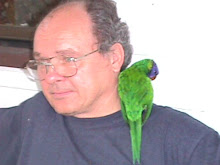 I remain a humble Pom at heart [aside: for those overseas readers who may be unfamiliar with the term, Pom is an endearing term often used by Australians when referring to those of us who arrived in this country from England]. I find it difficult to resist a wry smile when I listen to the natives, particularly those enamoured of Queensland [the Sunshine State], wax lyrically that this is “God’s own.” More often than not these sentiments are expressed when the ambient temperature is searing in the high thirties to mid-forties, with humidity at 100% or better. No wonder God chose the Middle East rather than Outback Australia as the earthbound home of His only begotton son!
I remain a humble Pom at heart [aside: for those overseas readers who may be unfamiliar with the term, Pom is an endearing term often used by Australians when referring to those of us who arrived in this country from England]. I find it difficult to resist a wry smile when I listen to the natives, particularly those enamoured of Queensland [the Sunshine State], wax lyrically that this is “God’s own.” More often than not these sentiments are expressed when the ambient temperature is searing in the high thirties to mid-forties, with humidity at 100% or better. No wonder God chose the Middle East rather than Outback Australia as the earthbound home of His only begotton son!This past Sunday however, we did experience a truly glorious morning. The temperature only grudgingly crawled above 15 Celsius; there was a crispness to the air that invigorated not only the lungs but the entire spirit. A slight mist came up from nearby watercourses setting an eerie tone to the immediate surroundings.
Admittedly the early part of the morning was not the best for birding, vision was limited to perhaps ten metres all around. On the other hand, where visual impressions were perhaps curtailed, aural perceptions seemed correspondingly enhanced.
In those pre-dawn hours before first light filtered through we could hear the distinctive call of the Southern Boobook Ninox novaeseelandiae [an owl of the Strigiformes], accompanied by the deep boom of the Tawny Frogmouth Podargus strigoides [a nightjar of the Caprimulgiformes]. Oddly enough the next call we heard, at 0555 hours [70 minutes prior to official sunrise that day] was the rather plaintive call of the Australian Wood [Maned] Duck Chenonetta jubata, followed a few minutes later by the somewhat harsh alarm call of the Masked Lapwing Vanellus miles.
The Laughing Kookaburra Dacelo novaeguineae, often the earliest herald of the dawn, was late that morning; its initial call coming only 42 minutes before sunrise rather than its more customary 50+ minutes prior to daybreak. Almost invariably it was followed by the truly melodic song of the Australian Magpie Cracticus tibicen.
By 0546 hours, still nineteen minutes before sunrise, the Yellow-faced Honeyeater Lichenostomus chrysops announced its presence. This honeyeater has featured almost regularly over the past week as part of the “Dawn Chorus”. To gauge the significance of this bird please note my earlier blog, Reflections on Some Honeyeaters.
 At 0554 hours the White-winged Choughs Corcorax melanorhamphos announced their arrival at the southern feeder, followed two minutes later by the raucous Apostlebirds Struthidea cinerea and finally, at 0557 hours [eight minutes before the time set for sunrise] a solitary Australian King-Parrot Alisterus scapularis added its sultry tones to the mounting cacophony around us.
At 0554 hours the White-winged Choughs Corcorax melanorhamphos announced their arrival at the southern feeder, followed two minutes later by the raucous Apostlebirds Struthidea cinerea and finally, at 0557 hours [eight minutes before the time set for sunrise] a solitary Australian King-Parrot Alisterus scapularis added its sultry tones to the mounting cacophony around us.That amounted to eighteen species from the first call of the Boobook to daybreak – and all mostly tallied while Fay and I lay in bed enjoying the first cup of tea for the day. Almost all. The earliest birds were down to me and my diabetic insomnia.
With daylight abroad came the Magpie-lark Grallina cyanoleuca and the endearing Willie Wagtail Rhipidura leucophrys. The Common Bronzewing Phaps chalcoptera, Variegated Fairy-wren Malurus lamberti and Little Lorikeet Glossopsitta pusilla added to the morning’s total. Sometime during the mid-morning, with temperatures still well below 20C, the White-browed Scrubwren Sericornis frontalis [see Missing in Action] and Striped Honeyeater Plectorhyncha lanceolata began flexing their vocal muscles.
From somewhere far off to the east Fay, whose hearing is far superior to mine, heard a Fan-tailed Cuckoo Cacomantis flabelliformis, a rarity at this time of the year; a little later the Eastern Whipbird Psophodes olivaceus was heard and finally, as we strolled around the dam we spotted a single White-faced Heron Egretta novaehollandiae perched high in a tall gum overlooking the water. It was around 10.30am, the temperature a little above 15C and a long list of chores awaited our attention but it had been a glorious morning for birds with a final tally of 36 species before we laid aside binoculars and notebook. 

Try that while sweltering under a blazing sun with the mercury already in the mid to high 20s by mid-morning!


